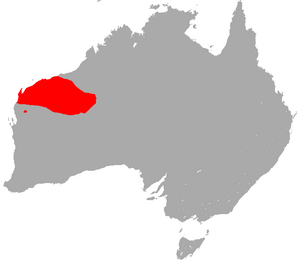Little red kaluta facts for kids
Quick facts for kids Little red kaluta |
|
|---|---|
| Conservation status | |
| Scientific classification | |
| Genus: |
Dasykaluta
|
| Species: |
rosamondae
|
 |
|
| Little Red Kaluta range | |
The little red kaluta, or simply kaluta, (Dasykaluta rosamondae) is a small, meat-eating marsupial. It is active at night, meaning it is a nocturnal animal. This creature lives in the dry areas of northwest Australia. Kalutas are about 100 millimeters (4 inches) long. They weigh between 20 and 40 grams (less than 2 ounces). In zoos or special care, they can live for about three years.
Contents
Naming the Kaluta (Taxonomy)
The little red kaluta is part of a family of marsupials called Dasyuridae. When it was first discovered in 1964, scientist W.D.L. Ride placed it in a group called Antechinus.
Later, in 1982, another scientist named Mike Archer created a new group just for this animal. He named this new group Dasykaluta. The little red kaluta is the only species in this group. Scientists have since found that it is most closely related to the Dibbler, another marsupial.
The name "Kaluta" comes from an Aboriginal language called Nyamal language. It is the local name for this animal. The scientific name Dasykaluta means "hairy kaluta." The species name, rosamondae, is a nod to Rosamund Clifford. She was a famous person in history known for her red hair.
Other common names for this animal include the little red antechinus, russet antechinus, and spinifex antechinus.
What Does a Kaluta Look Like? (Description)
The kaluta has fur that is a reddish-brown color. Its fur is quite coarse, meaning it feels a bit rough. It looks similar to other antechinus animals. However, the kaluta has a shorter head and smaller ears. It is also a bit smaller than these other animals.
This species is small and strong. Its body looks shaggy. The fur on its upper body is a uniform reddish-brown or coppery color. The fur on its belly is a lighter shade of the same color.
Size and Features
A kaluta's head and body together measure between 90 and 105 millimeters (about 3.5 to 4 inches). Its ears are short and covered in fur. They are a little taller than the top of its head and are about 11–13 millimeters long. The tip of its short nose is closer to its eyes than to its ears.
Its tail is fairly thick and short, measuring 55 to 75 millimeters (about 2 to 3 inches). Sometimes, the tail can be a bit swollen near its base. It tapers to a point and is never longer than two-thirds of the body length. The kaluta's back feet are 15–18 millimeters long and are also covered in fur.
Kaluta's Diet and Habits
The little red kaluta eats insects and small vertebrates. A cool thing it does is flick its tail in the air. It does this as it explores its home.
Life Cycle and Reproduction
Male little red kalutas, like some other dasyurid species, usually die shortly after the breeding season in September. This is a natural part of their life cycle.
Young kalutas are born after a pregnancy of about seven weeks. They are fed by their mothers until they are around four months old. At this age, they are ready to be on their own.
Where Kalutas Live (Habitat and Behaviour)
The little red kaluta is quite common in certain parts of Western Australia. These areas include the Pilbara, the western part of the Little Sandy Desert, and some areas of the Carnarvon Basin.
Their home is a subtropical environment. They live in mounds of Triodia, which is a type of grass. This grass is also known as spinifex. Spinifex grasslands are the main type of plants in these areas.
Kalutas live and search for food on the sandy soil of this region. They look for small creatures without backbones, like insects. They find their prey among the thick and tough mounds of spinifex grass.
See also
 In Spanish: Kaluta para niños
In Spanish: Kaluta para niños


